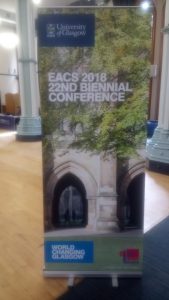Pia Eskelinen
The European Association for Chinese Studies (EACS) is an international organization representing China scholars from all over Europe. One of the Association’s major activities are the biennial conferences hosted by various centres of Chinese Studies in different European countries. The papers presented at these conferences comprise all fields from traditional Sinology to studies of modern China.

Kuva: Pia Eskelinen
My own research on Chinese rural women’s land rights was presented in the gender studies session and discussion in the session was very fruitful. First, Daria Berg (co-author Giorgio Strafella) presented their analyses on the rise of China’s new women cultural entrepreneurs (wenhua qiyejia) in China’s new mediasphere. And after my presentation, Yunyun Zhou told us stories of women cadres in leading positions in China’s local politics and their negotiations with the male-dominated political world.
In my presentation I had several key themes that I pointed out. The first, and in a way most important one, was the hierarchy in legislation and the problems there are in implementing national level legislation in the lower level governments and administrative bodies such as the village councils. The second theme was rural women themselves and how they are, not really deleted but diminished, from the scene of land rights in rural areas. My research wants to point out that rural women are a group of their own with their owns distinctive problems. And that they should be separated from rural people which normally equals to rural men. The third theme involved culture and its effects on legislation and patterns of administration the village councils use in land rights cases.

Picture: Pia Eskelinen, University of Glasgow, cloisters
The wide range of sessions included in the Conference were Chinese literature, politics, linguistics, law, modern history, sociology & anthropology, just to mention few. Glasgow University offered a spectacular setting for the conference. Established in 1451, participants were able to feel the atmosphere of traditions. Not least because the spectacular bell tower and beautiful archways, cloisters as they are actually called. The organizers of the conference did an amazing job in coordinating the over 80 parallel sessions and guiding over 250 presenters!
Pia Eskelinen is a PhD candidate at the University of Turku
Leave a Reply